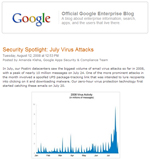Posted by //
Sean
Date and Time //
Aug 12, 08 - 1:05 pm
Categories //
Google
Security
Technology
RSS Feed //
RSS 2.0
 On its enterprise blog this afternoon, Google reported that it saw more infectious spam messages in July than any month so far this year.
On its enterprise blog this afternoon, Google reported that it saw more infectious spam messages in July than any month so far this year.
According to data gathered by Google’s Postini corporate e-mail security service, the volume of e-mail virus attacks peaked at almost 10 million on a single day, July 24.
That kind of volume, six to seven times what’s typical, means spam messages are getting through someone’s defenses and turning recipient’s machines into zombies, said Sundar Raghavan, a product marketing manager with the Google Apps Security & Compliance team.
“The summer of spam has caught up with us this time,” said Raghavan.
Raghavan suggests that in contrast to the message protection Google delivers from the Internet cloud, anti-spam hardware appliances that don’t update fast enough may allow malicious e-mail attacks to succeed.
Much of the spam that Google is seeing aims to exploit not browser or operating system vulnerabilities but user curiosity. Thus, explained Raghavan, spam now takes the form of spoofed CNN newsletters with link descriptions designed to bait the user, such as “Microsoft Bribes Chinese Officials.” Clicking such links in spam messages, however, generally leads to malware.
Raghavan also said that Google has seen an increase in e-mail messages with viruses concealed as encrypted .RAR attachments, despite an overall decrease in malicious attachments.
Marshal, an e-mail security company, this morning issued its security report covering the first half of 2008. In the first six months of 2008, the company says that spam volume doubled.
Marshal said that because of unpatched browsers, 45% of Internet users are at risk when they visit legitimate Web sites hosting malicious code. And there are many such sites. In May, the company identified 1.5 million Web sites infected with malware as a result of a botnet attack.
It may not come as a shock that Marshal, as a maker of e-mail security hardware, has more faith in e-mail security hardware than Google.
“We are now in the situation where spam accounts for almost 90 percent of all e-mail and increasingly contains links to infected sites,” said Bradley Anstis, VP of products, in a statement. “Companies really need to employ a combination of e-mail security gateways that have anti-spam protection using multiple techniques to block malicious content and secure Web gateway products that do not just rely on URL filtering but also scan the content that end users are downloading and uploading in real-time.”
E-mail users may also want to consider in-brain message filtering (no purchase required). Just as one might be skeptical of offers of wealth from a mysterious Nigerian benefactor, one might also refrain from clicking on links to suspect news stories along the lines of “Steve Jobs Uses Windows Vista At Home” or “Google Provides NSA With Real-Time Search Data.”
This entry was posted on Tuesday, August 12th, 2008 at 1:05 pm and is filed under Google, Security, Technology. You can follow any responses to this entry through the RSS 2.0 feed.
Both comments and pings are currently closed.
No Comments
Comments are closed.